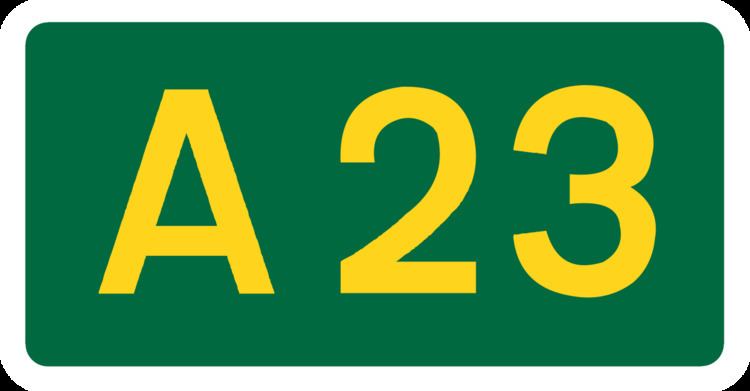 | ||
Primarydestinations: CroydonRedhillReigateGatwick AirportCrawley | ||
The A23 road is a major road in the United Kingdom between London and Brighton, East Sussex, England. It is managed by Transport for London for the section inside the Greater London boundary, Surrey County Council and West Sussex County Council for the section shadowed by the M23 motorway, the Highways Agency (as a trunk road) between the M23 and Patcham, and by Brighton and Hove Council from the A27 to the centre of Brighton.
Contents
- Map of A23 Redhill RH1 UK
- Route
- Major roads intersected by the A23
- History
- London to Brighton Veteran Run
- References
Map of A23, Redhill RH1, UK
The road has been a major route for centuries, and seen numerous upgrades, bypasses and diversions.
Route
The A23 begins as Westminster Bridge Road near Waterloo station. Almost immediately it turns south; the straightness of much of the heading south shows its Roman origins.
The road becomes:
Major roads intersected by the A23
History
What is now the A23 became an arterial route following the construction of Westminster Bridge in 1750 and the consequent improvement of roads leading to the bridge south of the river by the Turnpike Trusts. The increase in population of Brighton in the late eighteenth century, which transformed it from a small fishing village to a large seaside resort, enhanced the importance of this road, as did the residence there of George IV, as Prince of Wales, who made Brighton a place of fashion.
When roads were originally classified, the A23 started at Purley Cross. The road north of this section, including Purley Way, which opened to traffic in April 1925, was part of the A22. The current route north to Westminster Bridge dates from April 1935.
The A23 in London has frequently been one of the city's most congested roads. The M23 motorway was originally proposed to run as far north as Streatham, relieving congestion on the route, but the section north of Hooley was never built. At junction 7 of the M25 motorway, signs for the northbound M23 (which terminates a few miles to the north) simply read "Croydon" with no other London destinations marked.
In July 2000, control of the section of road inside the Greater London boundary was transferred from The Highways Agency to Transport for London. This caused delays to a planned relief road of Coulsdon, which had been announced in 1998. The then mayor, Ken Livingstone apologised in 2002 that TfL was unable to construct the relief road due to a lack of funds. The road was eventually completed in 2007, and which under TfL's ownership had acquired a bus lane that suffered ridicule for not having any buses actually running on it.
On 18 March 2010, plans to widen the section between Handcross and Warninglid in West Sussex to three lanes, removing an accident prone bend, were given the go ahead. Work started in autumn 2011.
London to Brighton Veteran Run
The 53-mile (85 km) road from London to Brighton forms the basis of the route of the annual London to Brighton Veteran Car Run. This is featured in the film Genevieve, although most of the rural motoring scenes were shot in Buckinghamshire. The A23 is also used for various other London to Brighton events, although in many cases part of the route diverges to parallel roads to reduce congestion or add variety.
